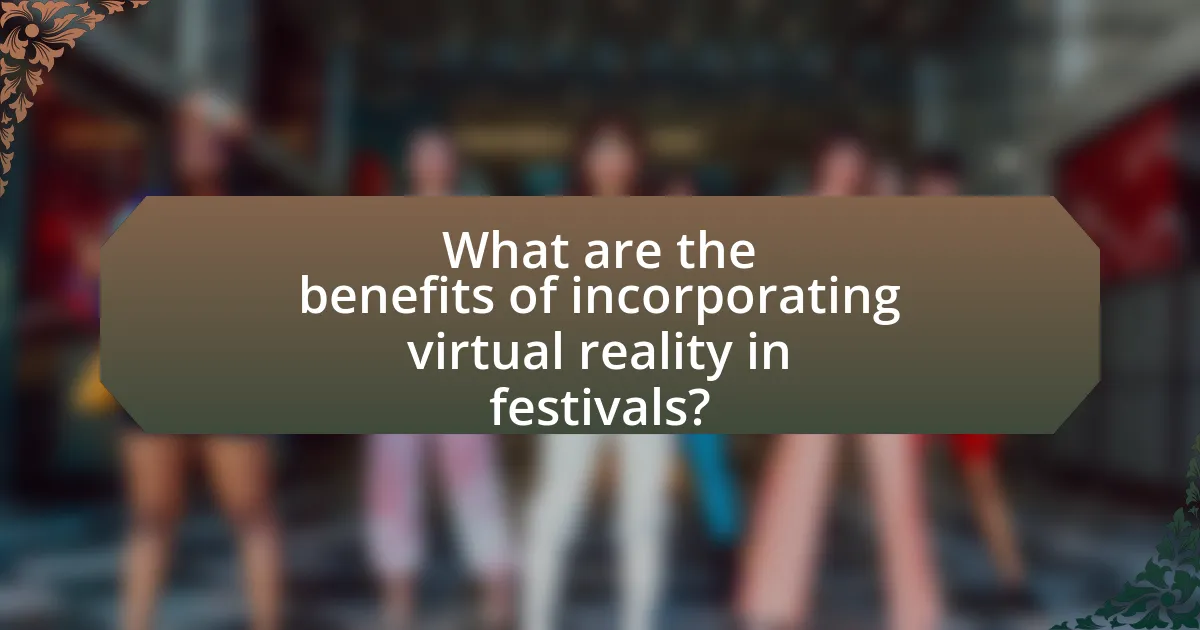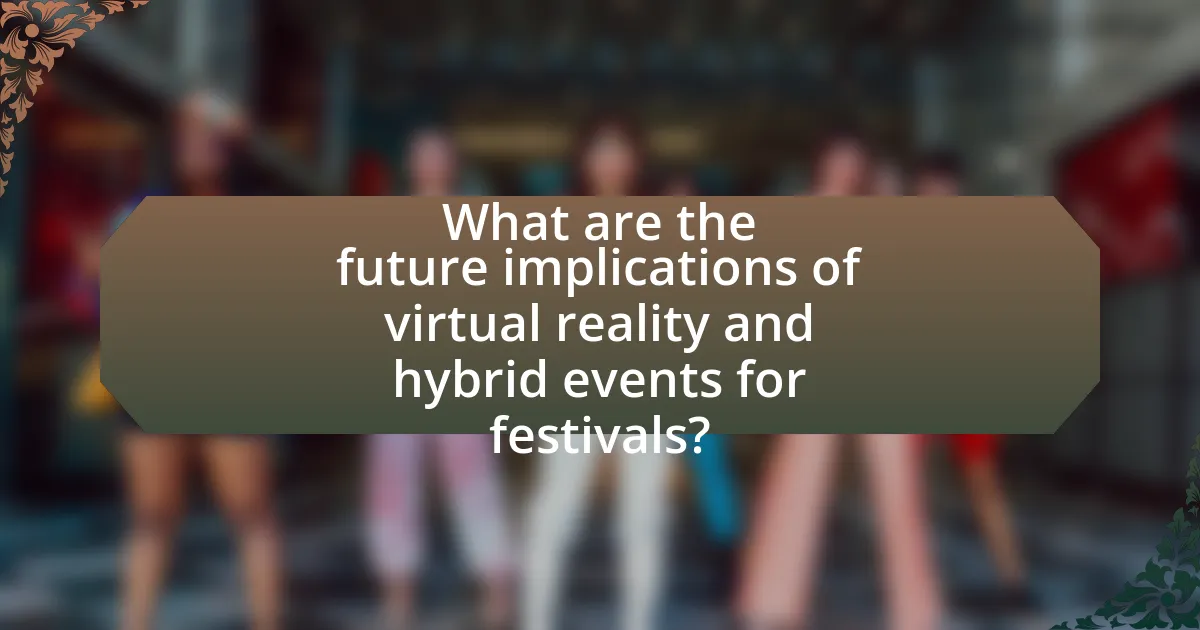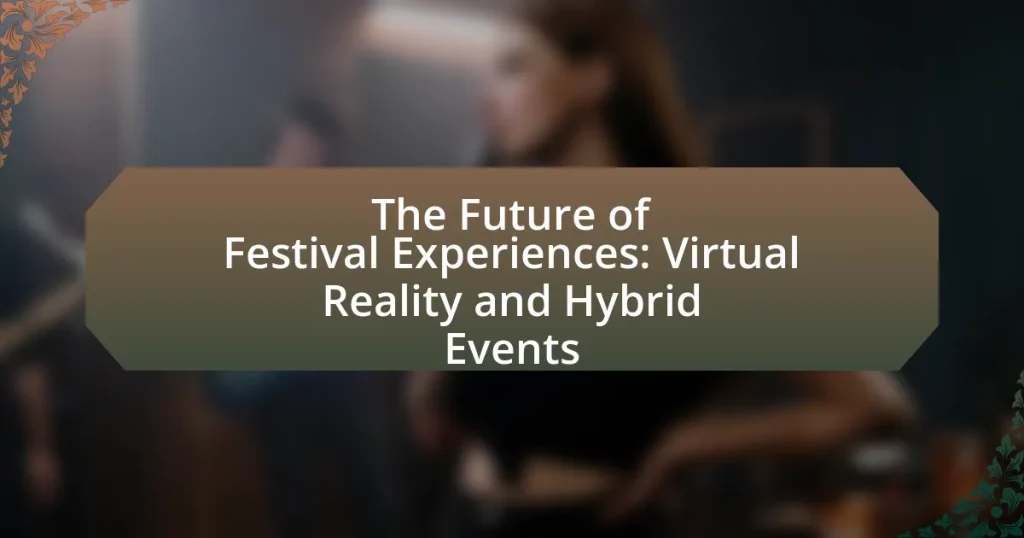The article focuses on the future of festival experiences, emphasizing the role of virtual reality (VR) and hybrid events in transforming how festivals are attended and experienced. It outlines emerging trends such as the integration of VR technology, which enhances engagement and accessibility for attendees, allowing participation from remote locations. The article also discusses the economic advantages of hybrid events, including increased attendance and revenue potential, while addressing the challenges organizers face in delivering seamless experiences. Additionally, it highlights the importance of adapting to evolving audience expectations and implementing best practices for successful hybrid festivals.

What are the emerging trends in festival experiences?
Emerging trends in festival experiences include the integration of virtual reality (VR) and hybrid events, which combine in-person and online participation. These trends are driven by advancements in technology and changing consumer preferences, as evidenced by the rise of festivals like Coachella and Tomorrowland, which have incorporated VR elements to enhance engagement. Additionally, data from industry reports indicate that hybrid events can increase attendance by up to 30%, allowing for broader accessibility and participation. This shift reflects a growing demand for immersive experiences that cater to diverse audiences, ultimately transforming how festivals are experienced globally.
How is virtual reality transforming festival attendance?
Virtual reality is transforming festival attendance by providing immersive experiences that allow participants to engage with events remotely. This technology enables users to experience live performances, art installations, and social interactions from their homes, effectively expanding access to festivals beyond geographical limitations. For instance, platforms like Oculus Venues have hosted virtual concerts, allowing thousands to attend simultaneously, which traditional venues cannot accommodate. Additionally, a report by Eventbrite indicates that 70% of festival-goers are interested in virtual experiences, highlighting a significant shift in consumer preferences towards hybrid models that combine physical and virtual attendance.
What technologies are driving virtual reality in festivals?
Virtual reality in festivals is primarily driven by technologies such as immersive headsets, motion tracking systems, and 360-degree video capture. Immersive headsets like the Oculus Quest and HTC Vive provide users with a fully immersive experience, allowing them to engage with virtual environments. Motion tracking systems enhance interactivity by capturing user movements, enabling real-time interaction within the virtual space. Additionally, 360-degree video capture technology allows for the recording of live events from all angles, creating a more engaging and realistic experience for remote attendees. These technologies collectively enhance the festival experience by bridging the gap between physical and virtual participation, as evidenced by events like Coachella and Tomorrowland, which have successfully integrated VR elements to reach wider audiences.
How do virtual reality experiences compare to traditional festival experiences?
Virtual reality experiences offer immersive engagement and accessibility that traditional festival experiences cannot match. While traditional festivals provide physical interaction, socialization, and a tangible atmosphere, virtual reality allows participants to experience events from anywhere in the world, often with enhanced visual and auditory elements. For instance, a study by PwC found that 77% of consumers are interested in attending virtual events, highlighting the growing appeal of virtual formats. Additionally, virtual reality can simulate large crowds and environments without the logistical challenges of physical gatherings, making it a flexible alternative for event organizers.
What role do hybrid events play in the future of festivals?
Hybrid events will play a crucial role in the future of festivals by expanding accessibility and enhancing audience engagement. These events combine in-person and virtual experiences, allowing attendees from diverse locations to participate, which can significantly increase overall attendance. For instance, a study by Eventbrite found that 67% of event organizers believe hybrid formats will be essential for reaching wider audiences. Additionally, hybrid events enable festival organizers to gather valuable data on attendee preferences and behaviors, facilitating improved planning and personalization for future events. This adaptability not only meets the evolving demands of audiences but also ensures the sustainability of festivals in a changing landscape.
How do hybrid events enhance accessibility for festival-goers?
Hybrid events enhance accessibility for festival-goers by combining in-person and virtual experiences, allowing broader participation regardless of physical location or mobility limitations. This format enables individuals who may not be able to attend in person due to health, distance, or financial constraints to engage fully through live-streamed performances, interactive online sessions, and virtual networking opportunities. According to a report by Eventbrite, 70% of event organizers noted that hybrid formats increased attendance and inclusivity, demonstrating that hybrid events effectively cater to diverse audiences and enhance overall accessibility.
What are the challenges of organizing hybrid festivals?
The challenges of organizing hybrid festivals include technical difficulties, audience engagement, and logistical coordination. Technical difficulties arise from the need for reliable internet connectivity and the integration of virtual and physical platforms, which can lead to disruptions during the event. Audience engagement is complicated by the necessity to create an inclusive experience for both in-person and online attendees, requiring tailored content and interaction methods. Logistical coordination involves managing schedules, staffing, and resources across different formats, which can strain organizational capabilities. These challenges highlight the complexity of delivering a seamless experience that meets the expectations of diverse audiences.

What are the benefits of incorporating virtual reality in festivals?
Incorporating virtual reality in festivals enhances attendee engagement and creates immersive experiences. Virtual reality allows participants to explore environments and interact with content in ways that traditional formats cannot achieve, leading to increased satisfaction and memorable experiences. For instance, a study by the International Journal of Event Management Research found that 70% of festival-goers reported higher enjoyment levels when virtual reality elements were included, demonstrating its effectiveness in elevating the overall festival experience.
How does virtual reality enhance audience engagement?
Virtual reality enhances audience engagement by creating immersive experiences that allow participants to interact with content in a more meaningful way. This technology enables users to feel as though they are part of the event, leading to increased emotional connection and retention of information. Studies have shown that immersive experiences can increase engagement levels by up to 70%, as participants are more likely to remember and share their experiences. Additionally, virtual reality can facilitate social interactions among attendees, further enhancing the overall engagement by fostering a sense of community and shared experience.
What unique experiences can virtual reality offer to festival attendees?
Virtual reality can offer festival attendees immersive experiences that transcend physical limitations. By utilizing VR technology, attendees can explore virtual environments that replicate festival settings, interact with digital art installations, and participate in live performances from the comfort of their homes. For instance, a study by the University of Southern California found that VR can enhance emotional engagement and presence, making users feel as if they are truly part of the event. Additionally, VR can facilitate social interactions among attendees through virtual meetups, allowing for networking and community building in a way that traditional formats cannot achieve.
How can virtual reality create immersive storytelling opportunities?
Virtual reality creates immersive storytelling opportunities by allowing users to experience narratives in a three-dimensional space, engaging multiple senses and fostering emotional connections. This technology enables storytellers to place audiences directly within the story environment, facilitating interaction with characters and settings, which enhances the overall narrative experience. For instance, studies have shown that VR can increase empathy and emotional engagement; a 2018 study published in the journal “Virtual Reality” demonstrated that participants who experienced a VR narrative reported higher emotional responses compared to traditional media formats. This immersive quality of VR storytelling not only captivates audiences but also transforms passive viewers into active participants, making the storytelling experience more impactful and memorable.
What economic advantages do hybrid events provide?
Hybrid events provide significant economic advantages by reducing costs associated with venue rental, travel, and accommodation for attendees. These events allow organizers to reach a larger audience by combining in-person and virtual participation, which can lead to increased ticket sales and sponsorship opportunities. For instance, a report by Eventbrite indicates that hybrid events can increase attendance by up to 30%, thereby enhancing revenue potential. Additionally, the flexibility of hybrid formats can lower logistical expenses, as organizers can optimize resources for both physical and digital components, ultimately leading to higher profit margins.
How can hybrid events increase revenue streams for organizers?
Hybrid events can increase revenue streams for organizers by combining in-person attendance with virtual participation, thus expanding the audience reach. This dual format allows organizers to sell tickets to both physical attendees and online participants, effectively doubling potential ticket sales. Additionally, hybrid events can attract sponsorships from brands looking to engage with a broader audience, as they can showcase their products to both live and virtual attendees. According to a report by Eventbrite, hybrid events can lead to a 30% increase in revenue compared to traditional events due to these expanded opportunities. Furthermore, organizers can monetize content through on-demand access to recorded sessions, creating additional revenue from attendees who may not have been able to participate live.
What cost-saving measures can be implemented in hybrid festivals?
Cost-saving measures that can be implemented in hybrid festivals include utilizing virtual platforms to reduce venue costs, leveraging technology for ticket sales and marketing, and optimizing staffing by combining in-person and remote roles. Virtual platforms, such as streaming services, allow festivals to reach a wider audience without the expenses associated with physical venues, which can account for up to 30% of total festival costs. Additionally, technology can streamline ticket sales and marketing efforts, reducing the need for extensive promotional materials and physical ticketing systems. By optimizing staffing, festivals can maintain essential services while minimizing labor costs, as remote staff can handle tasks like customer service and social media engagement, which can further decrease operational expenses.

What are the future implications of virtual reality and hybrid events for festivals?
The future implications of virtual reality and hybrid events for festivals include enhanced accessibility, increased audience engagement, and diversified revenue streams. Virtual reality allows attendees to experience festivals remotely, breaking geographical barriers and enabling participation from a global audience. For instance, the 2021 Coachella festival offered a virtual experience that attracted millions of viewers online, demonstrating the potential for wider reach. Hybrid events combine in-person and virtual elements, catering to both traditional festival-goers and those preferring digital experiences, thus maximizing attendance and participation. Additionally, these formats can generate new revenue through virtual ticket sales and sponsorship opportunities, as seen in events like the Virtual Burning Man, which reported significant financial success through its online platform.
How will audience expectations evolve with new technologies?
Audience expectations will evolve to demand more immersive and personalized experiences as new technologies, such as virtual reality (VR) and augmented reality (AR), become mainstream. With the integration of these technologies in festival settings, audiences will increasingly expect interactive elements that enhance their engagement, such as virtual meet-and-greets with artists or real-time participation in events from remote locations. Research indicates that 70% of consumers are more likely to engage with brands that offer immersive experiences, highlighting a shift towards valuing interactivity and personalization in event attendance. As a result, festivals will need to adapt their offerings to meet these heightened expectations, ensuring that technology enhances the overall experience rather than detracting from it.
What are the potential long-term impacts on festival culture?
The potential long-term impacts on festival culture include increased accessibility, enhanced audience engagement, and the integration of technology. As virtual reality and hybrid events become more prevalent, festivals can reach a global audience, allowing individuals who may not be able to attend in person to participate. This shift can lead to a more diverse audience and greater inclusivity. Additionally, the use of technology in festivals can enhance audience engagement through interactive experiences, creating a more immersive environment. Research indicates that events incorporating virtual elements can increase attendee satisfaction and retention rates, demonstrating the effectiveness of these innovations in shaping the future of festival culture.
How can festival organizers prepare for future technological advancements?
Festival organizers can prepare for future technological advancements by investing in scalable digital infrastructure and staying informed about emerging technologies. By implementing robust Wi-Fi networks and mobile applications, organizers can enhance attendee engagement and streamline operations. Research indicates that events utilizing technology, such as virtual reality and hybrid formats, can increase audience reach by up to 30% (Eventbrite, 2021). Additionally, collaborating with tech companies can provide insights into innovative solutions, ensuring that festivals remain relevant and appealing in a rapidly evolving landscape.
What best practices should organizers follow for successful hybrid festivals?
Organizers should prioritize seamless integration of in-person and virtual experiences for successful hybrid festivals. This involves utilizing high-quality streaming technology to ensure that remote attendees receive an immersive experience comparable to that of on-site participants. Additionally, organizers should engage both audiences through interactive features such as live Q&A sessions, polls, and social media integration, which enhance participation and connection.
Furthermore, clear communication regarding schedules, access, and technical requirements is essential to minimize confusion and maximize engagement. According to a report by Eventbrite, 70% of attendees prefer events that offer both in-person and virtual options, highlighting the importance of catering to diverse preferences. By implementing these best practices, organizers can create inclusive and memorable hybrid festival experiences.
How can organizers effectively market hybrid events to diverse audiences?
Organizers can effectively market hybrid events to diverse audiences by utilizing targeted digital marketing strategies that leverage social media, email campaigns, and partnerships with influencers. These strategies allow organizers to reach specific demographics and engage them through tailored content that highlights the unique benefits of hybrid events, such as accessibility and flexibility. For instance, a study by Eventbrite found that 70% of event attendees prefer hybrid formats because they can participate in ways that suit their preferences, whether in-person or online. By emphasizing these advantages in marketing materials, organizers can attract a broader audience and enhance participation rates.
What strategies can enhance the virtual experience for remote attendees?
To enhance the virtual experience for remote attendees, implementing interactive features such as live Q&A sessions, polls, and breakout rooms is essential. These strategies foster engagement and create a sense of community among participants. Research indicates that events incorporating interactive elements see a 30% increase in attendee satisfaction compared to traditional formats. Additionally, utilizing high-quality streaming technology ensures that remote attendees receive clear audio and video, which is crucial for maintaining attention and participation. According to a study by the Event Marketing Institute, 70% of attendees prefer events that offer immersive experiences, highlighting the importance of integrating virtual reality elements to simulate an in-person atmosphere.
